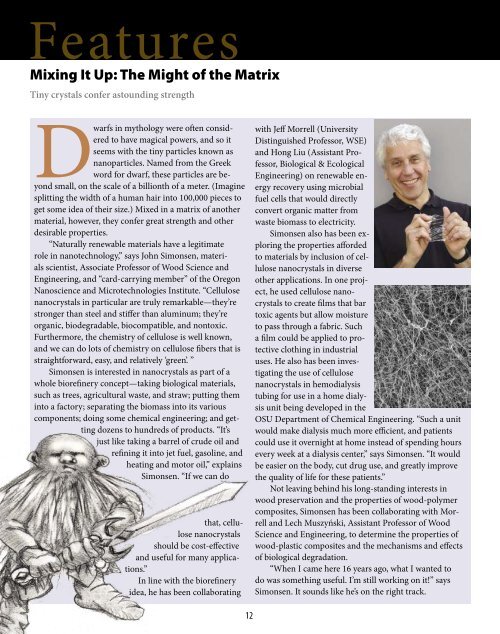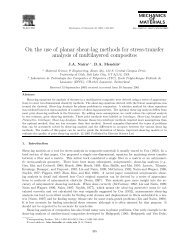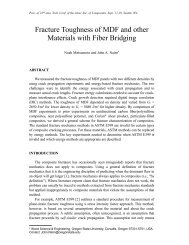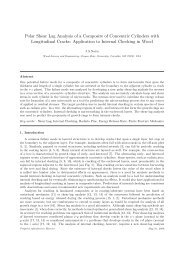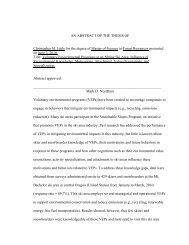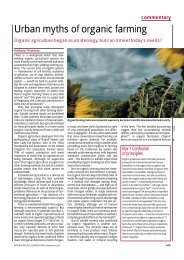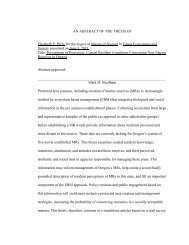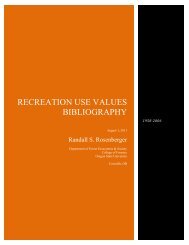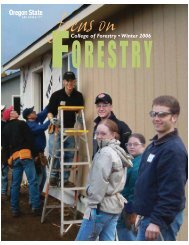College of Forestry - Oregon State University
College of Forestry - Oregon State University
College of Forestry - Oregon State University
You also want an ePaper? Increase the reach of your titles
YUMPU automatically turns print PDFs into web optimized ePapers that Google loves.
Features<br />
Mixing It Up: The Might <strong>of</strong> the Matrix<br />
Tiny crystals confer astounding strength<br />
Dwarfs in mythology were <strong>of</strong>ten considered<br />
to have magical powers, and so it<br />
seems with the tiny particles known as<br />
nanoparticles. Named from the Greek<br />
word for dwarf, these particles are beyond<br />
small, on the scale <strong>of</strong> a billionth <strong>of</strong> a meter. (Imagine<br />
splitting the width <strong>of</strong> a human hair into 100,000 pieces to<br />
get some idea <strong>of</strong> their size.) Mixed in a matrix <strong>of</strong> another<br />
material, however, they confer great strength and other<br />
desirable properties.<br />
“Naturally renewable materials have a legitimate<br />
role in nanotechnology,” says John Simonsen, materials<br />
scientist, Associate Pr<strong>of</strong>essor <strong>of</strong> Wood Science and<br />
Engineering, and “card-carrying member” <strong>of</strong> the <strong>Oregon</strong><br />
Nanoscience and Microtechnologies Institute. “Cellulose<br />
nanocrystals in particular are truly remarkable—they’re<br />
stronger than steel and stiffer than aluminum; they’re<br />
organic, biodegradable, biocompatible, and nontoxic.<br />
Furthermore, the chemistry <strong>of</strong> cellulose is well known,<br />
and we can do lots <strong>of</strong> chemistry on cellulose fibers that is<br />
straightforward, easy, and relatively ‘green’. ”<br />
Simonsen is interested in nanocrystals as part <strong>of</strong> a<br />
whole biorefinery concept—taking biological materials,<br />
such as trees, agricultural waste, and straw; putting them<br />
into a factory; separating the biomass into its various<br />
components; doing some chemical engineering; and getting<br />
dozens to hundreds <strong>of</strong> products. “It’s<br />
just like taking a barrel <strong>of</strong> crude oil and<br />
refining it into jet fuel, gasoline, and<br />
heating and motor oil,” explains<br />
Simonsen. “If we can do<br />
that, cellulose<br />
nanocrystals<br />
should be cost-effective<br />
and useful for many applications.”<br />
In line with the biorefinery<br />
idea, he has been collaborating<br />
with Jeff Morrell (<strong>University</strong><br />
Distinguished Pr<strong>of</strong>essor, WSE)<br />
and Hong Liu (Assistant Pr<strong>of</strong>essor,<br />
Biological & Ecological<br />
Engineering) on renewable energy<br />
recovery using microbial<br />
fuel cells that would directly<br />
convert organic matter from<br />
waste biomass to electricity.<br />
Simonsen also has been exploring<br />
the properties afforded<br />
to materials by inclusion <strong>of</strong> cellulose<br />
nanocrystals in diverse<br />
other applications. In one project,<br />
he used cellulose nanocrystals<br />
to create films that bar<br />
toxic agents but allow moisture<br />
to pass through a fabric. Such<br />
a film could be applied to protective<br />
clothing in industrial<br />
uses. He also has been investigating<br />
the use <strong>of</strong> cellulose<br />
nanocrystals in hemodialysis<br />
tubing for use in a home dialysis<br />
unit being developed in the<br />
OSU Department <strong>of</strong> Chemical Engineering. “Such a unit<br />
would make dialysis much more efficient, and patients<br />
could use it overnight at home instead <strong>of</strong> spending hours<br />
every week at a dialysis center,” says Simonsen. “It would<br />
be easier on the body, cut drug use, and greatly improve<br />
the quality <strong>of</strong> life for these patients.”<br />
Not leaving behind his long-standing interests in<br />
wood preservation and the properties <strong>of</strong> wood-polymer<br />
composites, Simonsen has been collaborating with Morrell<br />
and Lech Muszyński, Assistant Pr<strong>of</strong>essor <strong>of</strong> Wood<br />
Science and Engineering, to determine the properties <strong>of</strong><br />
wood-plastic composites and the mechanisms and effects<br />
<strong>of</strong> biological degradation.<br />
“When I came here 16 years ago, what I wanted to<br />
do was something useful. I’m still working on it!” says<br />
Simonsen. It sounds like he’s on the right track.<br />
12


